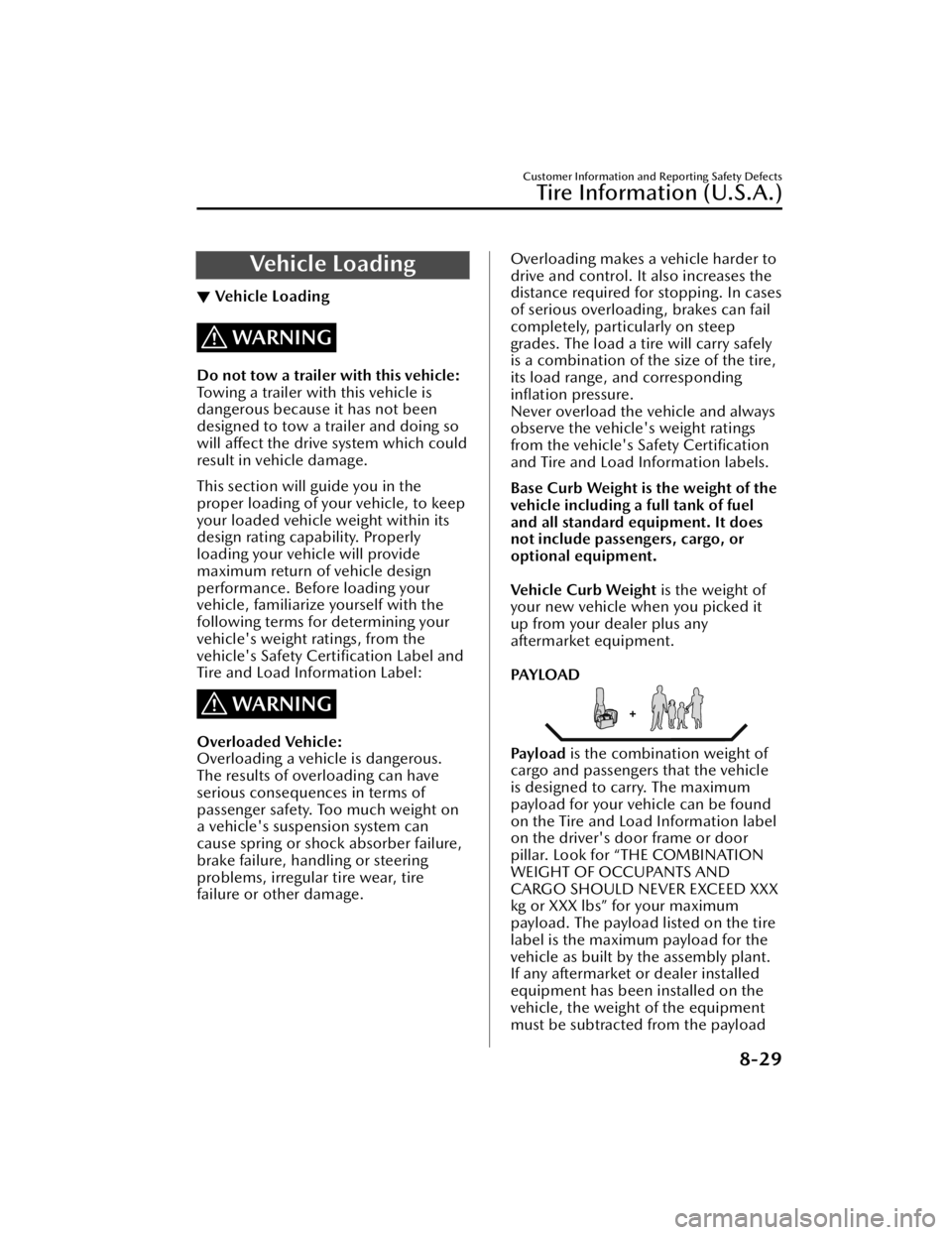steering MAZDA CX5 2023 Manual Online
[x] Cancel search | Manufacturer: MAZDA, Model Year: 2023, Model line: CX5, Model: MAZDA CX5 2023Pages: 583, PDF Size: 32.58 MB
Page 507 of 583

▼Tire Pressure Monitoring System
(TPMS) Warning Indication/
Warning Light (Turns on)
If a tire pressure decreases below the
specified air pressure, the TPMS
warning light turns on.
At the same time, a message and the
tire pressure of each tire are displayed
on the multi-information display
alternately. In addition, the tire (s) with
low air pressure is displayed in yellow.
WARNING
Do not drive the vehicle at high
speeds if the TPMS warning light turns
on or flashes:
Driving the vehicle at high speeds
while the TPMS warning light is turned
on or
flashing is dangerous because
the brake performance and the
steering wheel operability will be
reduced. If the vehicle is driven at high
speeds or the brakes are suddenly
applied, it could lead to an accident.
Gradually apply the brakes to lower the
vehicle's speed.
Do not ignore the TPMS warning light
when it is turned on or flashing:
Continuing to driv e the vehicle while
ignoring the illumi nation/flashing of
the TPMS warning light is dangerous
because a tire may burst which could
lead to an accident. Take appropriate
measures as soon as possible.
NOTE
While the TPMS is learning the tire
positions, such as immediately after a
tire position has been changed, the tire
pressure at the tire position prior to it
being changed is displayed until the
system completes the learning. For this
reason, the tire pressures displayed for
the tire positions may be different from
the actual tire pressures at the tire
positions.
Action to be taken
Adjust the tire pressures to the
appropriate pressures.
Refer to Tire Inflation Pressure on page
6-31.
If Trouble Arises
Warning/Indicator Lights and Warning Sounds
7-30
CX-50_8KB8-EA-22A_Edition2_new 2022-1-6 14:55:18
Page 549 of 583

Improper wheel alignmentOut-of-balance wheelSevere braking
After rotation, inflate all tire pressures
to specification on page 9-7 and
inspect the lug nuts for tightness.
CAUTION
Rotate unidirectional tires and radial
tires that have an asymmetrical tread
pattern or studs only from front to rear,
not from side to side. Tire performance
will be weakened if rotated from side
to side.
▼ Replacing a Tire
WARNING
Always use tires that are in good
condition:
Driving with worn tires is dangerous.
Reduced braking , steering , and
traction could result in an accident.
If a tire wears evenly, a wear indicator
will appear as a solid band across the
tread.
Replace the tire when this happens.
1. New tread
2. Worn tread
3. Tread wear indicator
You should replace the tire before the
band crosses the entire tread.
NOTE
Tires degrade over time, even when
they are not being used on the road. It
is recommended that tires generally be
replaced when they are 6 years or
older. Heat caused by hot climates or
frequent high load
ing conditions can
accelerate the aging process. You
should replace the spare tire when you
replace the other road tires due to the
aging of the spare tire. The period in
which the tire was manufactured (both
week and year) is indicated by a 4-digit
number.
Refer to Tire Labeling on page 8-22.
▼ Safety Practices
The way you drive has a great deal to
do with your tire mileage and safety.
So cultivate good driving habits for
your own benefit.
Observe posted speed limits and
drive at speeds that are safe for the
existing weather conditions
Avoid fast starts, stops and turnsAvoid potholes and objects on the
road
Do not run over curbs or hit the tire
against the curb when parking
CAUTION
If you feel a sudden vibration or ride
disturbance while driving or you
suspect your tire or vehicle has been
damaged, immediately reduce your
speed. Drive with caution until you can
safely pull
off the road. Stop and
inspect the tire for damage. If the tire
is under-inflated or damaged, deflate
it, remove the tire and rim and replace
it with your spare tire. If you cannot
detect a cause, have the vehicle towed
to the nearest vehicle or tire dealer to
have the vehicle inspected.
Customer Information and Reporting Safety Defects
Tire Information (U.S.A.)
8-28
CX-50_8KB8-EA-22A_Edition2_new 2022-1-6 14:55:18
Page 550 of 583

Ve h i c l e L o a d i n g
▼Ve h i c l e L o a d i n g
WARNING
Do not tow a trailer with this vehicle:
Towing a trailer with this vehicle is
dangerous because it has not been
designed to tow a trailer and doing so
will
affect the drive system which could
result in vehicle damage.
This section will guide you in the
proper loading of your vehicle, to keep
your loaded vehicle weight within its
design rating capability. Properly
loading your vehicle will provide
maximum return of vehicle design
performance. Before loading your
vehicle, familiarize yourself with the
following terms for determining your
vehicle's weight ratings, from the
vehicle's Safety Certification Label and
Tire and Load Information Label:
WARNING
Overloaded Vehicle:
Overloading a vehicle is dangerous.
The results of overloading can have
serious consequences in terms of
passenger safety. Too much weight on
a vehicle's suspension system can
cause spring or shock absorber failure,
brake failure, handling or steering
problems, irregular tire wear, tire
failure or other damage.
Overloading makes a vehicle harder to
drive and control. It also increases the
distance required for stopping. In cases
of serious overloading, brakes can fail
completely, particularly on steep
grades. The load a tire will carry safely
is a combination of the size of the tire,
its load range, and corresponding
inflation pressure.
Never overload the vehicle and always
observe the vehicle's weight ratings
from the vehicle's Safety Certification
and Tire and Load Information labels.
Base Curb Weight is the weight of the
vehicle including a full tank of fuel
and all standard equipment. It does
not include passengers, cargo, or
optional equipment.
Vehicle Curb Weight is the weight of
your new vehicle when you picked it
up from your dealer plus any
aftermarket equipment.
PAY LOA D
Pay l o a d is the combination weight of
cargo and passengers that the vehicle
is designed to carry. The maximum
payload for your vehicle can be found
on the Tire and Load Information label
on the driver's door frame or door
pillar. Look for “THE COMBINATION
WEIGHT OF OCCUPANTS AND
CARGO SHOULD NEVER EXCEED XXX
kg or XXX lbs” for your maximum
payload. The payload listed on the tire
label is the maximum payload for the
vehicle as built by the assembly plant.
If any aftermarket or dealer installed
equipment has been installed on the
vehicle, the weight of the equipment
must be subtracted from the payload
Customer Information and Reporting Safety Defects
Tire Information (U.S.A.)
8-29
CX-50_8KB8-EA-22A_Edition2_new 2022-1-6 14:55:18
Page 580 of 583

Index
Mazda Radar Cruise Control with
Stop & Go function (MRCC with Stop
& Go function) System
Warnings.................................. 7-40
Message Indicated on Multi-
information Display................... 7-32
Meters...................................... 4-18
MirrorsOutside mirrors.................... 3-32
Rearview mirror.................... 3-34
Mirror Defogger........................ 4-60
Multi-information Display.......... 4-20
O
Outside Mirrors.........................3-32
Overhead Console.................... 5-49
Overhead Lights........................ 5-39
Overheating.............................. 7-15
Overloading.............................. 3-51
Owner Maintenance Closing the hood..................6-13
Engine compartment
overview.............................. 6-14
Key battery replacement........6-29
Opening the hood................ 6-12
Owner maintenance
precautions.......................... 6-11
P
Panorama sunroof..................... 3-39
Parking Brake............................ 4-68
Parking Sensor System............. 4-215
Power Liftgate........................... 3-22
Power Liftgate Warning Beep...... 7-38
Power Steering.......................... 4-88
Power Windows........................ 3-36
R
Rearview Mirror........................ 3-34
Rear Coat Hooks....................... 5-49
Rear Cross Tra ffi c Alert (RCTA) ...........
.............................................. 4-113
Rear Cross Traffic Alert (RCTA)
Warning Beep........................... 7-39
Rear Door Child Safety Locks..... 3-18
Rear Side Radar Sensor............ 4-195
Rear View Monitor.................. 4-206 Displayable range on the
screen................................ 4-208
Rear view monitor
operation........................... 4-210
Rear view parking camera
location............................. 4-207
Switching to the rear view monitor
display............................... 4-208
Variance between actual road
conditions and displayed
image................................ 4-213
Viewing the display.............4-209
Rear Window Defogger............. 4-59
Rear Window Washer................ 4-58
Rear Window Wiper.................. 4-58
Recommended Oil.................... 6-16
Recording of Vehicle Data..........8-19
Recreational Towing.................. 3-61
Registering Your Vehicle in A Foreign
Country.................................... 8-15
Replacement Fuse..................................... 6-35
Key battery........................... 6-29
Light bulbs........................... 6-34
Tires.....................................6-32
Wheel.................................. 6-34
Wiper.................................. 6-22
Road Keep Assist.....................4-144
Rocking the Vehicle................... 3-49
S
Safety Defects, Reporting
(Canada).................................. 8-13
10-7
CX-50_8KB8-EA-22A_Edition2_new 2022-1-6 14:55:18
Page 581 of 583

Index
Safety Defects, Reporting
(U.S.A.).................................... 8-12
Saving Fuel and Protection of the
Environment............................. 3-46
Scheduled MaintenanceCanada.................................. 6-6
Mexico.................................. 6-8
U.S.A. and Puerto Rico........... 6-4
Seats Driver's seat........................... 2-4
Front passenger's seat........... 2-12
Front seat............................... 2-4
Head restraint...................... 2-15
Rear seat.............................. 2-13
Seat ventilation.................... 2-19
Seat warmer......................... 2-17
Seat Belt System Automatic locking................ 2-24
Emergency locking................ 2-24
Extender.............................. 2-29
Pregnant women.................. 2-24
Seat belt precautions............ 2-22
Seat Belt Warning Beep............. 7-36
Security System Immobilizer system............... 3-42
Theft-deterrent system.......... 3-44
Shift Position Warning Beep....... 7-38
Smart Brake Support (SBS)....... 4-148 Stopping the Smart Brake Support
(SBS) system operation........4-155
Spare Tire................................... 7-3
Spare Tire and Tool Storage.......... 7-3
Specifications Capacities.............................. 9-5
Dimensions............................ 9-6
Electrical system..................... 9-4
Engine................................... 9-4
Light bulbs............................. 9-7
Lubricant quality..................... 9-4
Tires.......................................9-7
Weights................................. 9-6SRS Air BagsDriver and front passenger
occupant classification
system................................. 2-67
How the SRS air bags work.... 2-60
Limitations to SRS air bag...... 2-65
Monitoring........................... 2-71
SRS air bag deployment
criteria................................. 2-63
Supplemental restraint system
components......................... 2-58
Supplemental restraint system
(SRS) precautions................. 2-52
Starting the Engine...................... 4-5
Steering Wheel Heated steering wheel.......... 2-20
Horn.................................... 4-61
Storage Compartments.............. 5-49 Center console..................... 5-50
Glove compartment..............5-50
Luggage compartment.......... 5-50
Overhead console................ 5-49
Sunshade.................................. 3-40
Sunvisors.................................. 5-38
T
Theft-Deterrent System.............. 3-44
Three-flash Turn Signal...............4-54
Tiedown Hook.......................... 7-18
Tires......................................... 6-31 Replacing a tire.................... 6-32
Replacing a wheel................ 6-34
Snow tires............................ 3-50
Specifications......................... 9-7
Temporary spare tire............. 6-33
Tire chains............................3-50
Tire inflation pressure............6-31
Tire rotation......................... 6-32
Uniform tire quality grading
system (UTQGS)................... 8-20
10-8
CX-50_8KB8-EA-22A_Edition2_new 2022-1-6 14:55:18